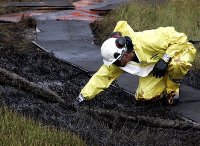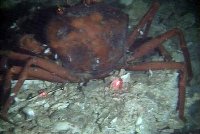
Katrina, Haiti, the Gulf: we hear news reports as these calamitous events transpire; we see pictures that evoke empathy, sympathy, and compassion; we have and hear discussions about relief efforts and rebuilding enterprises. But, after a few days these stories fade to the background of the news cycle. As the days and weeks pass, references become more and more infrequent, and, as a result, concern for the affects and aftermath of these events begins to shift to more current happenings. Yet, occasionally, a news report revisits the past and inquires into the status of the recovery project. Seth Borenstein’s article “Scientist finds Gulf Bottom still Oily, Dead” for the Associated Press is one such report.

Samantha Joye, a marine biologist from the University of Georgia, and her team recently completed five expeditions in the Gulf of Mexico. The aim of these expeditions was to investigate the Gulf’s rate of recovery from the decimating BP oil spill of April 2010 that gushed millions of gallons of oil into the delicate ecosystem. After covering 2,600 square miles of ocean and taking 250 core samples from the sea floor, Joye and her team discovered that the Gulf’s recovery has neither been as fast nor as extensive as the report commissioned by Kenneth Feinberg, the government official responsible for dispensing compensatory funds in the Gulf, claimed. Feinberg’s report indicated that the Gulf would nearly be restored to health by 2012; but, according to Joye, “It’s not going to be fine by 2012.” Continuing, Joye said, “I’ve been to the bottom. I’ve seen what it looks like with my own eyes. You see what the bottom looks like, you have a different opinion.”
Joye’s research team concluded that the “magic microbes,” those that had been injected into the spill zone and were reported to have done “great work munching the oil,” had only consumed “maybe 10 percent of the total discharge.” Much of the remaining oil coats the sea floor and is severely impacting the Gulf’s marine life. In their report, Joye’s team included pictures of “oil-choked” sea creatures that were “suffocating” and “pale, loose and dead.” Not only did her team find blankets of crude oil on the sea floor, they also discovered soot from oil that had been set ablaze. Accompanying the crude and soot was also a “tremendous” amount of methane gas that had been injected into to Gulf by BP – the “equivalent of between 1.5 and 3 million barrels of oil,” Joye reported.

Clearly, the devastating explosion of the Deepwater Horizon oil rig is a complicated issue with innumerable effects that have varying degrees of consequence. Communities, families, individuals, livelihoods, sea creatures, beaches, coral, and more have been affected; and, restoring and rehabilitating these and determining who is responsible, what should be done, who should complete it, and who should fund it is a daunting project. The findings of Joye’s research team remind us of another important component: the practice of accountability. Since there are so many competing interests involved in catastrophes of this magnitude, there needs to be vigilance in respect to follow through in two key areas. First, accountability must accompany the determinations of the “who’s”and “what’s” listed above; and second, accountability must accompany the processes of fulfilling the tasks of restoration and rehabilitation in order to facilitate equity, quality, and completion. As Liberal Evangelicals who are familiar with the Gospels, the practice of accountability may bring to mind passages where Jesus speaks of God’s judgment. Judgment may be perceived as a final, once-and-for-all event, or it may also be conceived as an ongoing process, a “checking-in,” an evaluative look, similar to a teacher looking over a student’s shoulder, a manager inquiring into the course of a project, and a parent supervising a child. Being concerned with well-being, equity, and justice, LE’s are keenly aware of the need, and role of, the practice of accountability.
Links
To read Seth Borenstein’s article “Scientist finds Gulf Bottom still Oily, Dead” in full click here.

